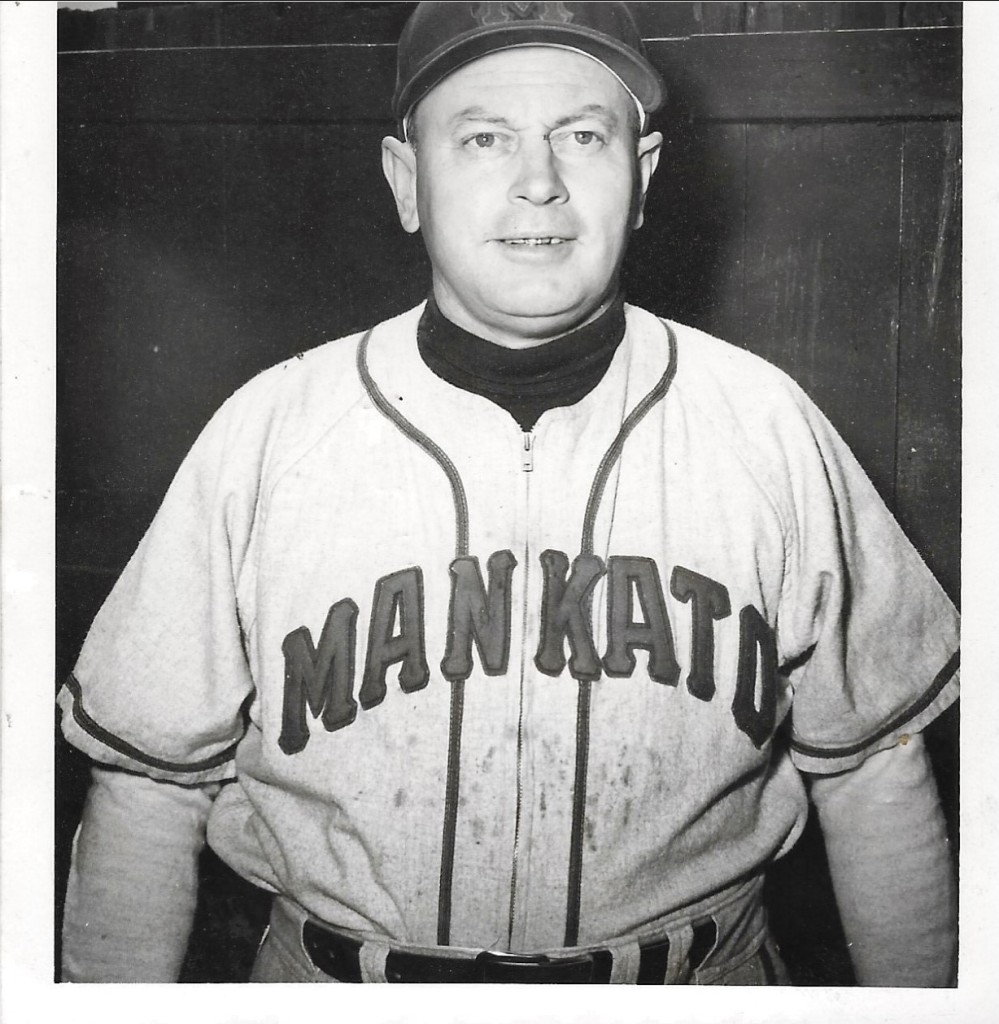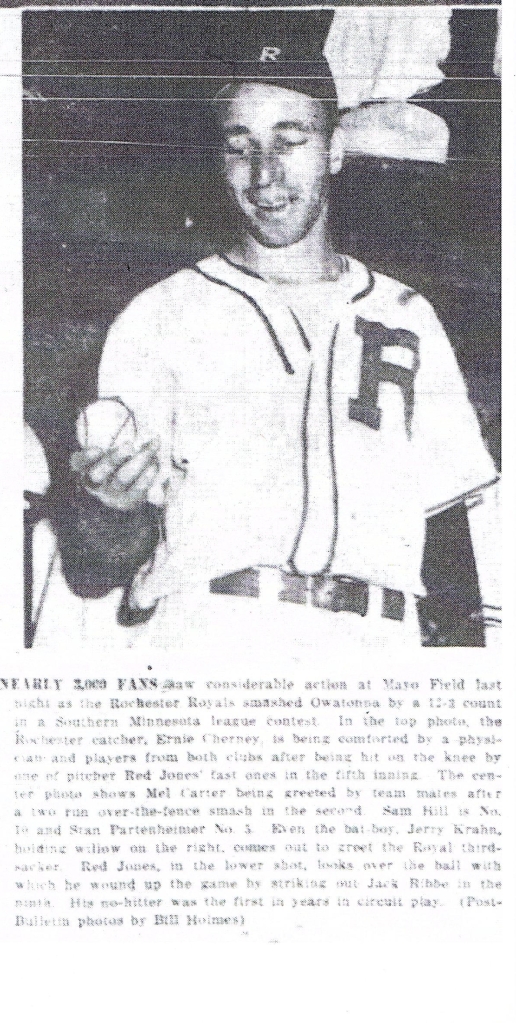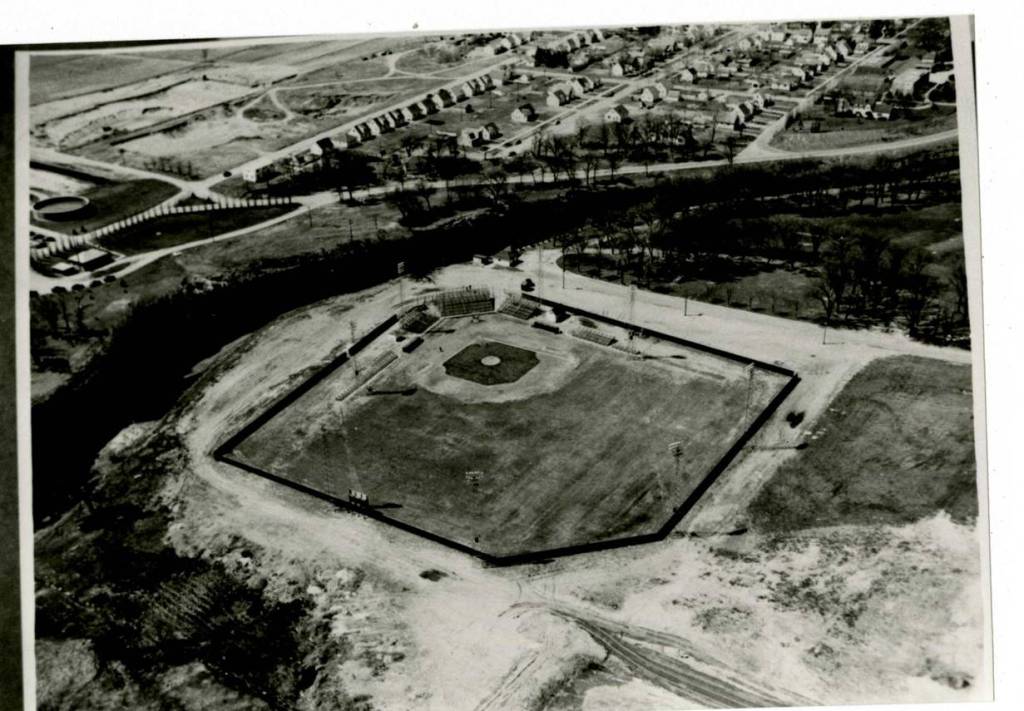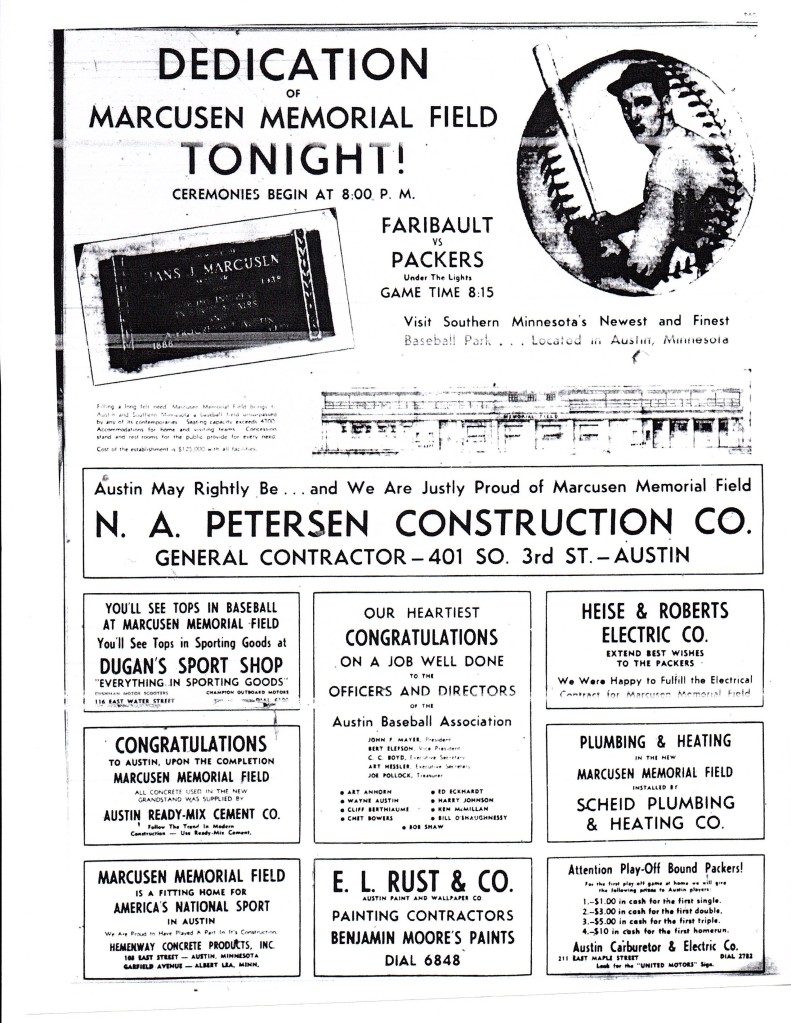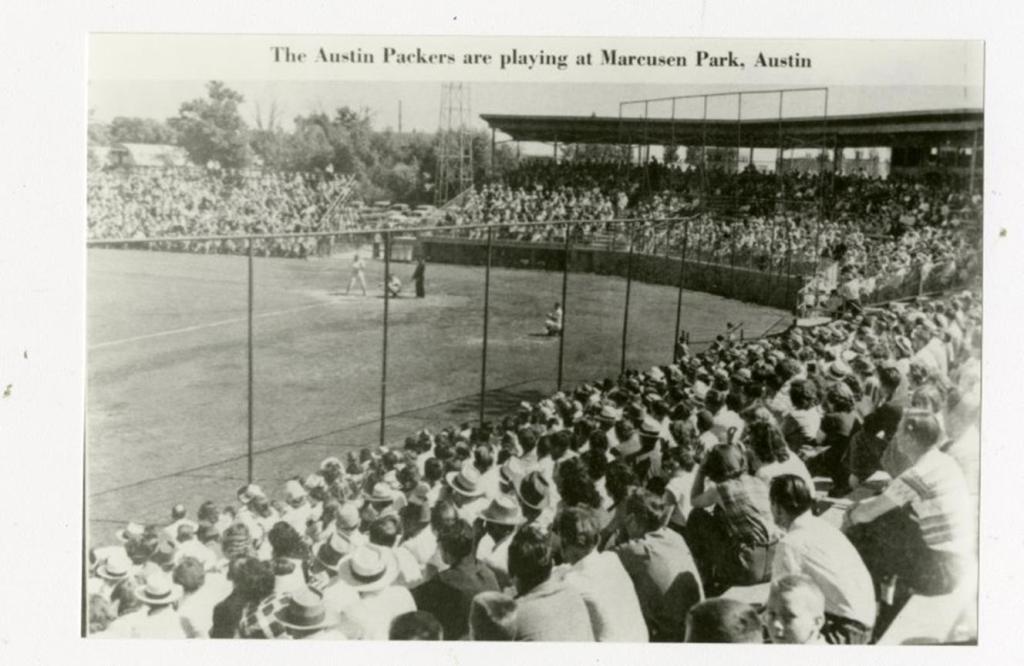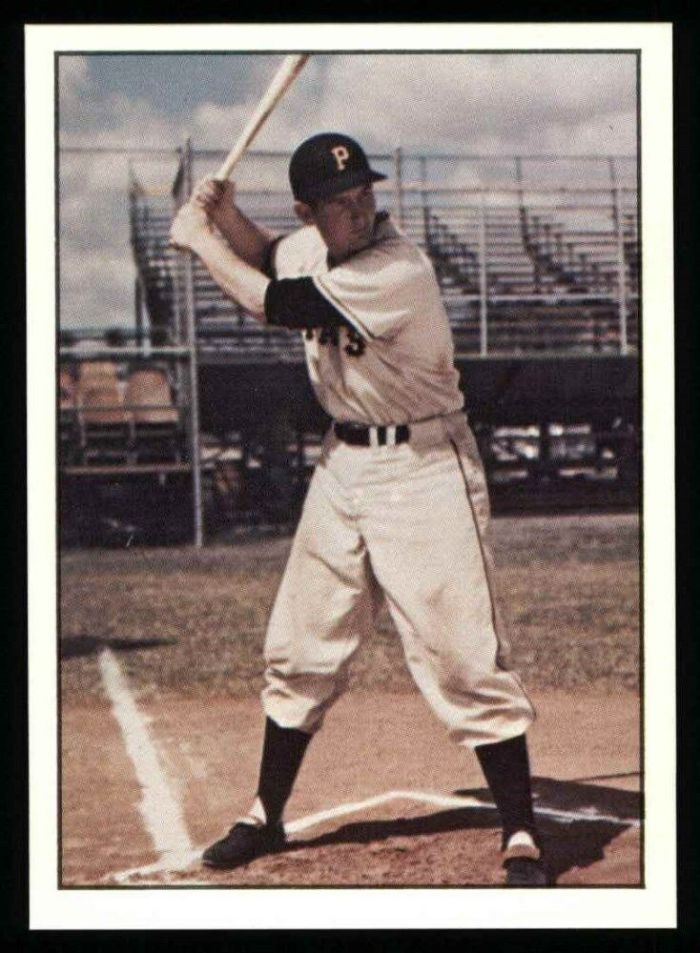On June 20, 1951, the Winona Republican-Herald wrote of Austin’s Big Carl DeRose that
“Never before has a Southern Minnesota league hurler notched a record to equal DeRose’s current string. Colossal Carl took home his ninth straight victory without a loss.”[1]
Carl DeRose deserved all of the many accolades he receives for his 1951 season with the Austin Packers. His victory string actually extended beyond nine games and he was truly a dominant and durable pitcher that season. He was the pitcher of record in 22 of the Packers 42 regular season games. He won 17 of those 22 games and one of the losses was a game he started on one days rest.
Lamenting another loss to Big Carl DeRose and the Austin Packers the Winona Daily News wrote:
“Carl DeRose wrote another chapter in his book, ‘How I Handcuffed Winona in ’51,’ at Marcusen Park Tuesday night.”[2]
If Big Carl DeRose wrote a book on every team he handcuffed during his career, there would be a Carl DeRose library. His career not only featured an unblemished win streak to the Southern Minny season in 1951 but absolute perfection when he completely handcuffed the Minneapolis Millers with no hits, no runs and no base runners in a perfect game pitched for the Kansas City Blues in 1947. That amazing feat, the first perfect game in the history of the American Association, was accomplished with an ailing arm and under the threat of surgery.
What seems to truly stand out about Big Carl DeRose, however, is his unwillingness to give up the game of baseball. That stubbornness may have led him to many places other than the promised land of Yankee Stadium but he never gave up the game of baseball and continued to work hard to get back to being a pitching ace after years of arm trouble.
The first rumors of Carl’s signing with the Austin Packers appeared prior to the final game of the 1950 Iowa State League Playoffs. [3] DeRose built up his arm strength during the ISL season to become one of the dominant pitchers on the Spencer Cardinals staff and he was expected to pitch the next playoff game for Spencer against the Carroll Merchants. The Carroll Daily Times Herald followed up with its own report following the conclusion of the 1951 Iowa State League Playoffs that DeRose would “move to Austin and work in the meat packing plant this winter and pitch in the Southern Minny league next summer.”[4] DeRose won the Cardinals’ final game of the season to claim the ISL Playoff Championship after setting aside the regular season champion Carroll Merchants 10-1.[5]
In promoting the Packer’s upcoming 1951 season, Tom Koeck wrote that DeRose left professional baseball when his arm went sour.[6] Koeck may have been slightly off as to the timing of when DeRose’s arm went sour and when he left professional baseball but Koeck was certainly accurate in reporting that DeRose had “once been considered the pitching plum of the New York Yankees’ farm system” and that he was “best known for his perfect no-hit game with the Kansas City Blues of the American Association.”[7]
Gary Cieradkowski describes Carl’s background in Milaca, Minnesota and his status as a can’t miss prospect for the New York Yankees in his article “Carl DeRose: Aboslute Perfection.” Carl returned to Yankees spring training camp in 1946 after missing time due to service in World War II. A broken knuckle likely prevented him from staying with the Yankees as he was assigned to Kansas City for the season. He posted a 12 and 6 record with a 3.16 ERA for a team that finished 23 games out of first place.[8]
Carl returned home to California for the offseason and worked construction. Most of his work was heavy labor and he actually became too muscle bound. As a result, he was tabbed for Kansas City again instead of New York City when he wasn’t able to get loose.[9]
Slated to pitch an exhibition game in Denver on his birthday (April 12th), he made it through half a game before his arm began to ache. It was a cold and snowy day and he was unable to throw his fastball. He tried to get by on curveballs and change ups.[10]
Seeking an explanation, DeRose sought out a medical help. By the end of June he was told he had calcium deposits in his shoulder and he might never pitch again. The Yankees arranged for a surgery that might have been career ending.
Instead of walking away, Big Carl DeRose went to Kansas City Blues skipper Billy Meyer on July 25th asking for one more chance to pitch the following day. Meyer, a baseball lifer (and former Winona Pirate), felt he had no choice when DeRose “begged for just one more chance.”[11]
Not surprisingly, DeRose was in pain before even trying to warm up. While warming up, he found he was missing his fastball. All he had was curves, a change up and a lot of guts. His manager gave him the chance to bow out but DeRose would not back out.[12]
He didn’t have his fastball but he still had great control. He retired the first three batters and the Blues scored in their half of the first inning to stake him to a lead. He set the Millers down in the second inning but Meyer knew his pitcher was in trouble. Meyer had a pitcher warming in the bullpen and pleaded with DeRose to leave the game. With tears in eyes after every painful pitch, DeRose refused to throw in the towel and reached a three ball count only once and that being the last batter of the game. DeRose struck him out on a 3-2 fastball for only his second strikeout of the game.[13]
On the day, DeRose had faced and retired 27 Minneapolis Millers in row becoming the first American Association pitcher to throw a perfect game since 1902. He and his teammates celebrated in the locker room until they had to say goodbye. They were off on a northern road trip while DeRose had an appointment with a surgeon.[14]
As he signed with the Austin Packers in 1951, his arm trouble was clearly not career ending. It was, however, the end of any likelihood of making the major leagues. Big Carl split time between Portland and Kansas City in 1948 logging a total of 70 innings over 26 appearances. He appeared in three games with Portland in 1949 before spending the remainder of the season in AA Beaumont. He found himself back at Beaumont to start the 1950 season and appeared in five games[15] before deciding to make a change.
That change was signing with the Spencer Cardinals in the semi-pro Iowa State League for the 1950 season.[16] The only known connection between DeRose and Spencer, Iowa was eventual team manager Bill Burgess who had spent some time with Beaumont several years prior.[17]
The 1950 ISL season started slowly for DeRose as his arm was still sore and he wasn’t in top form for hurling. He was, however, one of the top sluggers in the league early in the season.[18] He played first base or in right field as he continued to work his way back to pitching form. He smacked a two run home run against Estherville.[19]
By July his arm was starting to warm up but he still lack consistency. He held the hard hitting Carroll Merchants in check striking out 13 over 11 innings.[20] Carroll got the better of him the next time battering him for 8 runs on 10 hits in the fifth inning alone.[21] It certainly wasn’t lack of effort. John Hart, longtime Spencer baseball supporter, described a half hour batting session thrown to him by DeRose.[22]
The hard work started to pay off in August when DeRose shut out the Schaller Red Caps on four hits. Only eight batters “dented the infield” off of him.[23] He even worked out of the pen throwing 4 2/3rds against the Estherville Red Sox in a losing effort.[24]
Facing Schaller again late in the season he gave up one hit less than his earlier outing as Spencer drubbed the Red Caps 18-1. DeRose also homered to help his own cause.[25] He had a near no-hitter against Storm Lake on September 1st giving up only two hits on a single and pop up that fell in front of home plate after the seventh inning.[26] The win eliminated the Storm Lake White Caps from the playoffs and advanced the Cardinals to the ISL finals which they took four games to one finishing off the Merchants 10-1 behind DeRose.
As the 1951 preseason progressed the Austin Daily Herald asked “Can Slabmen Go Distance? Reply Awaited.”[27] To that point, Emil’s pitchers had generally been splitting 3 to 4 innings of each game to get ready for the season. When the season arrived, at least one of the slabmen was ready to go and that was Big Carl DeRose.
The season actually started fairly inauspiciously for DeRose. His first pitch of the season was tagged for a double into left field. Carl got a strikeout but gave up a single and double to be down two runs. He then beaned John Ewaniak with a wild pitch that put Ewaniak’s entire season in jeopardy. Carl recovered to retire the side as he scattered six hits for the rest of the game.[28]
He followed up with a five hitter against the Fairmont Martins securing a shutout in a non-league game.[29] After that, he started writing the book about handcuffing Winona for a hard earned 4-3 win.[30] The Rochester Royals fell next 6-2 with DeRose allowing only seven hits.[31]
Against Albert Lea he was a dual threat holding the visitors to two singles over nine innings for his fourth straight win. He homered in the seventh to give himself the lead. The Packers were 1-3 on days when Big Carl didn’t start.[32]
Winona and Rochester fell in succession. Dick Seltz broke up a 1-1 tie in the ninth with a “spanking homerun over the rightfield fence” to give DeRose his fifth victory.[33] Carl gave up only seven hits to Rochester to win 5-2. He was working like an ace winning four of the last six games played by the Packers who were playing three games a week.[34]
DeRose limited Albert Lea to eight hits while Roy Gilmore lashed out a pair of home runs and a triple to pace the Austin offense to a 5-3 victory.[35] Big Carl picked up his eighth straight win giving up only one run on six hits to Waseca.[36] His ninth straight victory game included another chapter in the book against Winona. This time he won 5-3 pitching steady ball.[37]
He beat Waseca again to gain his 10th straight win. He had a shutout going into the ninth before giving up three runs late. He told that Austin Daily Herald that “It doesn’t make any difference what the score is, just so you win.”[38] He certainly did that in 1951.
Despite tiring in the ninth against Waseca, he was strong on the mound against Owatonna tossing a two hitter for his 11th straight victory.[39] All things come to an end, however, and the end of the consecutive wins streak came on July 3rd at Rochester. The Royals collected six hits in the first three innings. DeRose still went the distance and kept his team in the game only losing 4-2 despite not getting on track early in the game.[40]
To put some additional perspective on DeRose’s perfect winning streak of 11 straight wins to start the season, three pitchers tied for second in the league for games won with twelve games won for the entire season. Big Carl DeRose won nearly that many before the first of July.
The Packers’ offense took away any pressure in his next start collecting 21 hits. Even so, Carl kept Albert Lea’s hits fairly well scattered.[41] He dropped only his second game of the season on July 10th.[42] Not surprisingly Big Carl was named to the East All-Star Team.[43]
Big Carl got his revenge against the Royals blanking them on five hits.[44] He was asked to come back on only a day’s rest against Faribault. Not surprisingly he wasn’t quite as effective giving up 13 hits.[45]
Given a few more days rest and Winona as an opponent, he was good to go. He gave up only two hits in shutting out Winona for his 14th win in 17 starts.[46] Showing his durability, he went the distance in a 13 inning loss to Waseca.[47] He next set down Winona 9 to 1 for his 15th victory.[48]
He gave up only 10 hits and had three extra base hits of his own to spark a victory over Mankato.[49] He got his 17th win of the season by tossing a six hitter against Owatonna.[50]
It certainly wasn’t surprising that 17 game winner Big Carl DeRose got the ball for the first game of the Southern Minny Playoffs against Waseca. He didn’t disappoint fanning seven and walking only two while scattering seven hits. Roy Gilmore plated the winning run in the ninth on a towering home run.[51]
DeRose lost the third game 6-2 but rebounded to take the decisive fifth game 7-0.[52] He won game two of the League Finals 6-1. He was used a pinch batter in both games three and four.
Having reached their third consecutive state tournament, the Packers naturally turned the ball over the DeRose. He gave up a solo home run in the seventh while Bill Campeau’shomer in the same inning plated Bob Kuhlman for a hard fought 2-1 victory.[53] Carl lost a heartbreaker to Marshall to force the Packers to win out if they were going to claim the title.[54]
Carl did his part setting back Litchfield 4-2 to keep the Packers in the tournament in the afternoon game.[55] Unfortunately for the Packers DeRose was unavailable for the evening final game having pitched the early afternoon game and Arleigh Kraupa had been used to get to the Sunday games. With those two pitchers unavailable, the Packers were forced to use three pitchers while Litchfield needed only one to claim the state AA championship.
Big Carl DeRose was truly colossal for the Austin Packers in 1951. His string of consecutive wins is simply magical in the night baseball era of the Southern Minny. His 17 wins were 65% of the 26 total Packer wins during the regular season. In fact, the combined record of all Packer pitchers not named Carl DeRose was 9 wins and 11 losses. Without Big Carl’s perfect winning streak the Austin Packers may not have even made the Southern Minny Playoffs that season let alone the finals of the state AA championship for the third straight year.
[1] “DeRose Notches Ninth Straight Before 2,656,” Winona Republican-Herald, June 20, 1951, 16.
[2] “Winona Remains Game From 4th,” Winona Daily News, August 1, 1951, 12.
[3] Mason City Globe-Gazette, Sept. 8, 1950, 17.
[4] “To Austin,” Carroll Daily Times-Herald, Sept. 11, 1950, 3.
[5] “Spencer Wins Iowa State Playoffs,” Mason City Globe-Gazette, Sept. 9, 1950, 11.
[6] “Defending Champion Austin Packers Set for 3rd Title Effort,” Austin Daily Herald, April 26, 1951.
[7] Ibid.
[8] Gary Joseph Cieradkowski, “Carl DeRose: Absolutely Perfect,” https://studiogaryc.com/2019/01/17/carl-derose-absolutely-perfect/
[9] Ibid.
[10] Ibid.
[11] Ibid.
[12] Ibid.
[13] Ibid.
[14] “Pitches Perfect Game with Sore Arm,” Daily Times (Davenport, IA), June 27, 1947, 31.
[15] https://www.baseball-reference.com/register/player.fcgi?id=derose001car
[16] “Spencer’s Champions Again May Have a Strong Team,” Mason City Globe-Gazette, June 8, 1950, 20; “Iowa State Loop Pennant Race Underway in Earnest,” Estherville Daily New, June 9, 1950, 6.
[17] Brad Wilson, “Sports Parade,” Des Moines Register, August 21, 1950, 12.
[18] Mason City Globe-Gazette, June 14, 1950, 21.
[19] “Estherville Mauled in State Loop Game,” Sioux City Journal, June 14, 1950, 17.
[20] “Blanchard’s Bat Proves Difference, Carroll Wins; Spencer Plays Here Tonight,” Carroll Daily Times, July 6, 1950, 3.
[21] “Fifth Inning Explosion is Good for 10 Hits, 8 Runs,” Carroll Daily Times Herald, July 7, 1950, 11.
[22] Carroll Daily Times Herald, July 26, 1950, 3.
[23] “Spencer Cardinals Battle Carroll at Home Friday,” Ruthven Free Press, August 9, 1950, 4.
[24] “Locals Stave Off Enemy in 8th and 9th,” Estherville Daily News, August 19, 1950, 3.
[25] “Spencer Obliterates Schaller Nine, 18-1,” Sioux City Journal, August 26, 1950, 8.
[26] “Spencer’s In; DeRose Hurls 2 to 0 Shutout,” Carroll Daily Times, September 2, 1950, 3.
[27] “Packers Whip Mankato,” Austin Daily Herald, May 7, 1951.
[28] “Packers Rap Faribault, 22-5,” Austin Daily Herald, May 13, 1951, 10.
[29] “DeRose Scatters 5 Blows as Packers Rout Fairmont, 10-0,” Austin Daily Herald, May 19, 1951.
[30] “Late Rally Wins for Packers, 4-3,” Austin Daily Herald, May 23, 1951.
[31] “Harpuder, Gilmore Homer in 6-2 Win, Austin Daily Herald, May 28, 1951.
[32] “Packers Win 2 S-M League Contests,” Austin Daily Herald, May 31, 1951.
[33] “Seltz’s Homer Beats Winona,” Austin Daily Herald, Jun 4, 1951, 4.
[34] “Packers Defeat Rochester, 5-2, Behind DeRose,” Austin Daily Herald, June 8, 1951.
[35] “Gilmore and DeRose Pace 5-3 Victory,” Austin Daily Herald, June 11, 1951.
[36] “Austin Tightens Hold on S-M Lead,” Austin Daily Herald, June 15, 1951.
[37] “DeRose Bumps Chiefs 5-3 for 9th in a Row,” Austin Daily Herald, June 20, 1951.
[38] “Packers Defeat Waseca, 4-3, Austin Daily Herald, June 25, 1951.
[39] “One-Hitter by DeRose,” Austin Daily Herald, June 29, 1951.
[40][40] “Packers Fail in Two League Starts,” Austin Daily Herald, July 3, 1951, 10.
[41] “Collect 21 Hits for 17-4 Edge,” Austin Daily Herald, July 9, 1951.
[42] “First Win for Chiefs over Austin Since ’49,” Austin Daily Herald, July 11, 1951.
[43] “DeRose, Campeau, Lindgren and Gilmore on East Team,” Austin Daily Herald, July 14, 1951.
[44] “Gilmore and Campeau Spark Batting Attack,” Austin Daily Herald, July 16, 1951.
[45] “Riedesel, Faribault Rap Austin, 7-1,” Austin Daily Herald, July 18, 1951.
[46] “DeRose Blanks Winona Chiefs, 2-0,” Austin Daily Herald, July 23, 1951.
[47] “Waseca Nips Austin in 13 Innings,” Austin Daily Herald, July 27, 1951.
[48] “DeRose Handcuffs Winona, 9 to 1,” Austin Daily Herald, August 1, 1951.
[49] “DeRose Sparks Packer Victory,” Austin Daily Herald, August 6, 1951.
[50] “Austin Gains on Aces in Flag Chase,” Austin Daily Herald, August 10, 1951.
[51] “Packers Take Lead in S-M Playoff,” Austin Daily Herald, August 24, 1951, 8.
[52] “Faribault, Austin in Final Playoffs,” Austin Daily Herald, August 30, 1951.
[53] “Carl DeRose Stops Springfield, 2-1,” Austin Daily Herald, September 8, 1951, 5.
[54] “Austin Drops 7-6 Test to Marshall,” Austin Daily Herald, September 11, 1951.
[55] “Packers Spill Litchfield, 4-2 Behind DeRose,” Austin Daily Herald, September 18, 1951.

